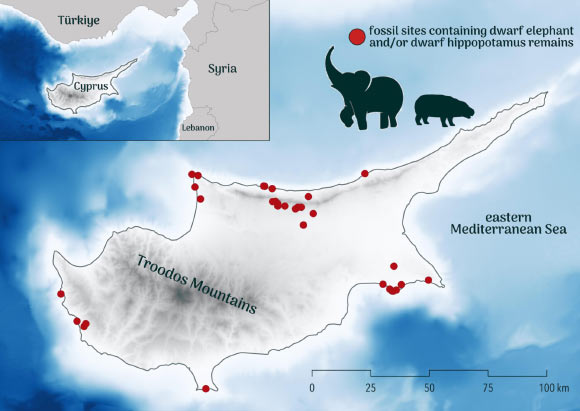
Around 3,000-7,000 hunter-gatherers on the Mediterranean island of Cyprus hunted endemic dwarf hippopotamus (Phanourios minor) and dwarf elephants (Palaeoloxodon cypriotes) to extinction within less than 1,000 years, according to new research led by Flinders University.

Map of Cyprus showing the approximate position of fossil sites where dwarf elephants and hippos have been retrieved. Image credit: Corey J.A. Bradshaw / Flinders University.
Cyprus offers an ideal set of conditions to test whether recently arrived populations of pre-agropastoralist humans had the capacity to drive megafauna species to extinction.
The two large species present on the island when people first arrived were Phanourios minor and Palaeoloxodon cypriotes.
Phanourios minor was the smallest dwarf hippopotamus in the Mediterranean region and weighed 130 kg at adulthood.
The species was adapted to a largely terrestrial, browsing lifestyle given its lower orbits and nostrils, loss of the 4th molar, brachydont molars, and a shortened and narrow muzzle when compared to semi-aquatic forms.
Ancient DNA analyses suggest Phanourios minor diverged from the common hippopotamus (Hippopotamus amphibius) approximately 1.4 to 1.6 million years ago.
Palaeoloxodon cypriotes weighed only about 530 kg and was therefore less than 10% of the size of its mainland ancestor.
The species probably derived from the straight-tusked elephant (Palaeoloxodon antiquus) that inhabited Europe and Western Asia during the Middle and Late Pleistocene.
In examining the reasons behind the extinction of these animals, Flinders University’s Professor Corey Bradshaw and colleagues found that Paleolithic hunter-gatherers on Cyprus could have first driven dwarf hippos, and then dwarf elephants to extinction in less than 1,000 years.
These findings refute previous arguments that suggested the introduction of a small human population on the island could not have caused these extinctions so quickly.
The researchers built mathematical models combining data from various disciplines, including paleontology and archaeology, to show that Paleolithic hunter-gatherers on Cyprus are most likely the main cause of the extinction of these species due to their hunting practices.
The authors used data-driven approaches to reveal the impact of rapid human settlement on driving the extinction of species soon after their arrival.
Using detailed reconstructions of human energy demand, diet composition, prey selection, and hunting efficiency, their model demonstrates that 3,000-7,000 hunter-gatherers predicted to have occurred on the island were likely responsible for driving both dwarf species to extinction.
“Our results therefore provide strong evidence that Paleolithic peoples in Cyprus were at least partially responsible for megafauna extinctions during the Late Pleistocene and early Holocene,” Professor Bradshaw said.
“The main determinant of extinction risk for both species was the proportion of edible meat they provided to the first people on the island.”
“Our research lays the foundation for an improved understanding on the impact small human populations can have in terms of disrupting native ecosystems and causing major extinctions even during a period of low technological capacity.”
The study was published in the Proceedings of the Royal Society B.
_____
Corey J.A. Bradshaw et al. 2024. Small populations of Palaeolithic humans in Cyprus hunted endemic megafauna to extinction. Proc. R. Soc. B 291 (2031): 20240967; doi: 10.1098/rspb.2024.0967
 Print
Print




